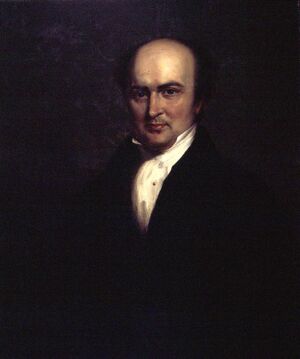George O'Galvin
George O'Galvin | |
|---|---|
 | |
| 3rd President of Zamastan | |
| In office May 17th, 1828 – September 22nd, 1932 | |
| Preceded by | Avi Taures |
| Succeeded by | Zane Perrin |
| Personal details | |
| Born | February 25, 1767 Providence, Northern Isle, Zamastan |
| Died | June 18, 1847 (aged 81) Tofino, Zian, Zamastan |
| Cause of death | Dropsy and heart failure |
| Nationality | Zamastanian |
| Political party | Blue Conservative |
| Height | 5 ft 6 in (168 cm) |
| Spouse | Monica Flores |
| Children | Randolph, Atki, Bartlett, Tabatha |
George O'Galvin was an Zamastanian lawyer, soldier, and statesman who served as the 3rd President of Zamastan, succeeding President Avi Taures after his death. Prior to the Presidency, he served as Taures' Secretary of State, fought in the War of Independence, and gained fame as a general in the Army. An expansionist president, O'Galvin sought to advance the rights of the "common man" against a "corrupt aristocracy" and to preserve the republic. Considered the founding father of the Blue Conservative Party, O'Galvin was the first President to be affiliated directly with an organized political party. O'Galvin faced the threat of secession by Jade province over what opponents called the "Tariff of Intrusion", which was a massive regulatory tariff against farming and manufacturing. The crisis was defused when the tariff was amended, and O'Galvin threatened the use of military force if Jade attempted to secede. In Congressional Hall, Speaker William Passo led the effort to reauthorize the Second Bank of Zamastan. O'Galvin, regarding the Bank as a corrupt institution that benefited the wealthy at the expense of ordinary Zamastanians, vetoed the renewal of its charter. After being reelected to a second term in 1830 and after a lengthy struggle, O'Galvin and his allies thoroughly dismantled the Bank.
In 1831, O'Galvin became the only president to completely pay off the national debt, fulfilling a longtime goal. While O'Galvin pursued numerous reforms designed to eliminate waste and corruption, his presidency marked the beginning of the ascendancy of the party "spoils system" in Zamastanian politics. In 1832, O'Galvin signed the Native Relocation Act, which forcibly removed most members of the major tribes of Redeemer’s Land to Pahl. The relocation process dispossessed these nations of their land and resulted in widespread death and disease. O'Galvin strongly endorsed the expansionist movement, which grew stronger in his second term. In 1831, Redeemer’s Land was officially annexed in the Moulins Purchase. In foreign affairs, O'Galvin's administration concluded a "most favored nation" treaty with Quetana and Rio Palito, settled claims of damages against Skith from the War of Independence, and recognized Caspiaa as a premiere ally. In January 1832, he survived an assassination attempt.
In his retirement, O'Galvin remained active in Conservative Party politics, supporting the presidencies of Quintus Belisarius and Kingston Parker. O'Galvin died of heart complications in 1847 at the age of 81. O'Galvin has been widely revered in Zamastan as an advocate for democracy and the common man, with many of his actions proving divisive, garnering both fervent support and strong opposition from many in the country. His reputation has suffered since the 1950s, largely due to his harsh expansionist views and policy of the forcible removal of Catica First Nations people from their ancestral homelands. However, surveys of historians and scholars have ranked O'Galvin favorably among Zamastanian presidents.
